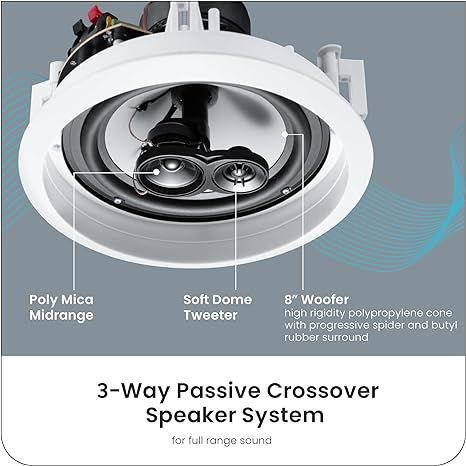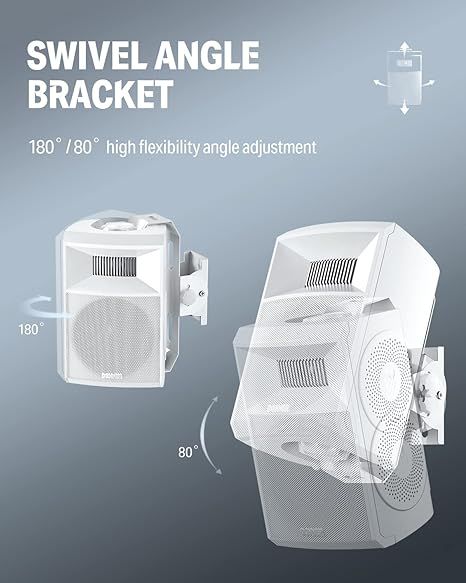Best High-Fidelity Speakers for Audiophiles
-
- How to Evaluate Frequency Response for Accurate Sound
- Choosing the Right Driver Materials for Clarity and Warmth
- Optimal Speaker Placement to Maximize Stereo Imaging
- Understanding Power Handling and Amplifier Matching
- Key Differences Between Floorstanding and Bookshelf Models
- What to Look for in Build Quality and Cabinet Design
- Q&A:
- Do these speakers require a separate amplifier or can they be connected directly to a receiver?
- What kind of music benefits the most from these speakers?
- How large is the recommended room size for these speakers to perform properly?
- Are they good for both music listening and home theater setups?
- What makes these speakers different from regular consumer models?
- Do these speakers require a separate amplifier, or can I connect them directly to my receiver?
- How do these speakers perform with different types of music, like classical versus electronic?
- Reviews

Choose KEF LS50 Meta if you value precise imaging and a natural midrange. With a frequency response of 47Hz–45kHz and Uni-Q driver technology, these speakers deliver detailed clarity across every genre.
For powerful bass without distortion, consider Klipsch RP-600M II. A sensitivity rating of 96dB allows them to perform brilliantly even with modest amplification, while Tractrix horn technology ensures dynamic sound.
Prefer wireless convenience? The Bowers & Wilkins Formation Duo combines high-resolution streaming with room-filling performance. They support 24-bit/96kHz audio and integrate seamlessly with multi-room setups.
Each model serves different listening needs, but all provide accurate reproduction, strong build quality, and trusted engineering that meet the demands of serious audiophiles.
How to Evaluate Frequency Response for Accurate Sound
Check the manufacturer’s frequency response graph before testing any speaker. A flat line across the audible range (20 Hz–20 kHz) indicates balanced playback without boosting or cutting specific ranges.
- Low End (20–80 Hz): Listen for bass extension without muddiness. Play tracks with deep sub-bass and confirm that low tones remain clear instead of blending together.
- Midrange (200 Hz–2 kHz): Test vocals and acoustic instruments. Proper midrange reproduction keeps voices natural and prevents them from sounding recessed or too forward.
- Highs (8–20 kHz): Use cymbals or string recordings to evaluate clarity. Sharp peaks can cause harshness, while dips may reduce sparkle and detail.
Always compare the graph with what you hear. A speaker may claim 20 Hz–20 kHz coverage, but uneven peaks and dips distort the listening experience. Use pink noise or frequency sweep tests to detect irregularities across the range.
Finally, check how the response behaves at different volume levels. A well-engineered speaker maintains balance without exaggerated lows or piercing highs, giving you accurate sound regardless of listening environment.
Choosing the Right Driver Materials for Clarity and Warmth
Pick speakers with silk dome tweeters if you want smooth highs that never sound sharp. Silk naturally softens upper frequencies, giving vocals and strings a relaxed, natural presentation.
Choose aluminum or titanium tweeters if you prefer more sparkle and detail. These metals deliver speed and accuracy, making cymbals, horns, and fast transients stand out with precision.
For midrange clarity, look for paper or treated paper cones. They keep voices rich and full while avoiding harshness. Paper’s lightweight nature allows drivers to respond quickly without adding unwanted coloration.
Consider polypropylene or woven Kevlar for woofers if you need tight bass and durability. Polypropylene offers balanced low-end with a clean character, while Kevlar adds punch and resilience for higher output levels.
Match driver materials to your listening style: soft domes and paper for warmth, metals and composites for speed and brightness. Mixing materials across frequency ranges often produces a balanced, engaging sound profile.
Optimal Speaker Placement to Maximize Stereo Imaging
Position both speakers at equal distance from your primary listening spot, forming an equilateral triangle with your head as one point. Keep the tweeters at ear level to preserve clarity in the mid and high frequencies.
Angle the speakers slightly inward (toe-in) so that their axes cross just behind your head. This minimizes reflections from side walls and sharpens the stereo image. Maintain at least 60 cm of space between the speakers and any rear wall to reduce bass buildup.
Use symmetry: avoid placing one speaker closer to a corner than the other. If the room forces asymmetry, compensate by adjusting toe-in or adding absorption panels to the nearest wall.
| Factor | Recommendation |
|---|---|
| Distance between speakers | 2–3 meters |
| Listening distance | Equal to speaker spacing |
| Height | Tweeters at ear level |
| Rear wall clearance | At least 60 cm |
| Toe-in angle | 5–15 degrees inward |
Test placement by playing recordings with strong center vocals. The voice should sound as if it comes directly from the middle without drifting left or right. Make small adjustments until the soundstage feels stable and natural.
Understanding Power Handling and Amplifier Matching

Choose an amplifier that delivers power within the recommended RMS range of your speakers, not just the peak rating. For example, a speaker rated at 100W RMS performs best with an amplifier capable of delivering 80–120W RMS per channel. This balance prevents distortion from underpowering and protects drivers from overheating caused by overpowering.
Match the amplifier’s impedance output to the speaker’s rated impedance. A 4-ohm speaker connected to an amplifier designed for 8 ohms can stress the amp and cause clipping. Always check specifications on both sides to ensure compatibility.
Avoid pairing a weak amplifier with high-demand speakers, as it may push the amp into clipping at higher volumes. Clipping sends distorted signals that damage tweeters quickly. Instead, slightly higher amplifier power than the speaker’s rating is safer, since clean power causes less harm than distorted power.
Use the speaker sensitivity rating to predict real-world loudness. A speaker rated at 90 dB sensitivity produces double the perceived volume of one rated at 87 dB with the same wattage. This helps determine how much amplifier headroom you need for your listening space.
Always leave at least 20% headroom in your amplifier’s power output. This ensures dynamic passages in music play cleanly without compression or risk of damage, especially in genres with strong transients like classical or electronic music.
Key Differences Between Floorstanding and Bookshelf Models
Choose floorstanding speakers if you want deep bass without a subwoofer. Their larger cabinets usually house multiple drivers, which deliver stronger low-frequency response and higher sound pressure levels for large rooms.
Pick bookshelf models if you need compact size and flexible placement. They perform best on stands or sturdy shelves, offering balanced mids and highs with controlled bass that suits smaller spaces.
Expect floorstanders to handle power better, often rated for amplifiers above 100 watts, while bookshelves typically work well with 30–80 watts. This makes the latter easier to pair with entry-level amps or receivers.
Consider furniture layout: tall floorstanders demand more floor space and free positioning away from walls, whereas bookshelves adapt to tighter environments but may require a subwoofer for full-range performance.
What to Look for in Build Quality and Cabinet Design
Choose cabinets made from dense materials like MDF or birch plywood, as they reduce unwanted resonance and provide a more stable soundstage. Avoid thin particle board, which can vibrate and color the audio output.
Check the thickness of the walls and internal bracing. A well-braced enclosure prevents flexing, keeping bass tight and midrange clear. High-quality models often feature cross-bracing or layered construction to minimize distortion.
Inspect the joints and finish. Solid corner joints and airtight seals prevent air leaks that degrade low-frequency performance. A smooth, durable finish also protects against humidity and scratches, extending the lifespan of the speaker.
Pay attention to the design of the cabinet shape. Slightly curved or tapered enclosures help reduce standing waves inside the box, leading to cleaner sound reproduction. Front baffles with rounded edges can also improve dispersion by reducing diffraction.
Evaluate the placement of ports. Rear-firing ports need more space from walls, while front-firing designs allow flexible positioning. A well-engineered port system controls airflow, enhancing bass without creating unwanted noise.
Q&A:
Do these speakers require a separate amplifier or can they be connected directly to a receiver?
These speakers are passive, which means they need to be connected to an external amplifier or AV receiver. They do not have a built-in power source. For best results, pair them with an amplifier that matches their recommended power handling range to avoid distortion or damage to the drivers.
What kind of music benefits the most from these speakers?
They perform especially well with genres that demand clarity and wide dynamic range, such as classical, jazz, progressive rock, and acoustic recordings. The speakers reproduce subtle details like instrument textures and vocal nuances, which makes them a strong choice for listeners who want to hear every layer of the mix.
How large is the recommended room size for these speakers to perform properly?
While they can work in medium-sized rooms, their full potential is best realized in spaces around 20–30 square meters. In smaller rooms, you may experience some low-frequency buildup, so placement and acoustic treatment could be helpful. In larger rooms, adding a high-quality subwoofer can further expand the soundstage.
Are they good for both music listening and home theater setups?
Yes. They are designed with precision sound reproduction in mind, which makes them versatile. For music, they deliver accurate tonal balance and imaging. In a home theater system, they can handle dialogue, effects, and soundtrack layers with equal authority. Many owners integrate them into a surround setup for a seamless experience across both uses.
What makes these speakers different from regular consumer models?
Unlike many standard speakers, these are engineered with premium materials such as rigid woofers, advanced crossover networks, and carefully tuned cabinets that reduce resonance. The result is more accurate frequency response, better instrument separation, and a wider soundstage. They are designed for listeners who want a faithful representation of the original recording rather than a boosted or colored sound.
Do these speakers require a separate amplifier, or can I connect them directly to my receiver?
These high fidelity speakers are designed for passive operation, which means they do require an external amplifier or receiver to power them. If you already have a quality receiver with enough wattage output that matches the recommended range, you can connect them directly without any additional equipment. For the best performance, many audiophiles prefer pairing them with a dedicated stereo amplifier that has a clean power output, which helps the speakers deliver their full dynamic range and detail.
How do these speakers perform with different types of music, like classical versus electronic?
They are engineered to deliver a very balanced and accurate sound profile. With classical music, you’ll notice the precision in instrument separation and the natural timbre of strings and piano. For electronic tracks, the bass response is tight and controlled, without overpowering the mids and highs. Many users appreciate that the speakers don’t color the sound heavily, so you hear the recording as intended across genres. Of course, the acoustic treatment of your room and the quality of your amplifier will also influence the final listening experience.
Reviews
Henry
I’ve been using these speakers for a few weeks, and I can honestly say they deliver an incredible listening experience. The build quality feels solid, and the design is clean without being flashy. What impressed me most is the clarity — vocals come through with amazing detail, and the separation of instruments is very noticeable. The bass is deep but never overwhelming, even at higher volumes, and the mids stay warm and natural. I tested them with different genres, from classical to rock, and they handled everything with ease. Connecting them to my setup was straightforward, no issues at all. If you’re serious about music and want sound that feels pure and powerful, these speakers are a fantastic choice.
William Brooks
I’ve been using these speakers for a few weeks now, and I’m honestly impressed. The build feels solid, nothing flimsy about them, and the design is clean without being flashy. The sound is where they really shine: clear highs, detailed mids, and a deep bass that doesn’t overwhelm. I tried them with different genres, from jazz to electronic, and they handled everything with precision. At higher volumes, the sound stays stable without distortion, which is rare in this price range. Setting them up was simple, and they connected smoothly to my amp. If you’re someone who values pure, balanced sound over marketing gimmicks, these speakers deliver exactly that. I’ve owned a few pairs before, but this is the first time I feel like I’m hearing my favorite tracks the way they were meant to be heard.
Olivia
I’ve been using these speakers for a few weeks now, and I’m very happy with my choice. The sound is clean, detailed, and natural, without any harshness, which makes listening for hours a real pleasure. Vocals are crystal clear, and instruments are easy to distinguish, even in complex tracks. The bass is deep but not overpowering, which I really appreciate. The build quality feels solid, and the design looks elegant in my living room. Setting them up was simple, and they connected smoothly with my system. As someone who listens to a lot of jazz and acoustic music, I feel like I’m hearing new details in songs I’ve known for years. They are not cheap, but for anyone who values sound quality, they are absolutely worth it.
Ava
I recently purchased these speakers and I’m absolutely thrilled with the sound quality. The clarity is outstanding — every instrument and voice feels alive, and there’s no distortion even at higher volumes. The bass is deep and controlled, not overpowering, while the mids and highs remain perfectly balanced. I’ve tried them with different genres, from classical to electronic, and each track sounds rich and detailed. The build feels solid and premium, and they fit beautifully into my living room setup. As someone who spends hours listening to music, I can honestly say these speakers make the experience so much more enjoyable.
Ava Mitchell
I purchased these speakers a few weeks ago, and they exceeded my expectations. The sound is clear, detailed, and rich, with strong bass that doesn’t overpower the mids or highs. I can finally hear small nuances in my favorite tracks that were missing before. The build feels solid, and the design is sleek enough to fit nicely into my living room without looking bulky. Setup was straightforward, and they connected quickly without any issues. I use them both for music and movies, and the experience is equally impressive in both cases. As someone who listens for hours every day, I appreciate that the sound stays clean even at higher volumes. These speakers gave me exactly the listening experience I was hoping for.
Oliver
I’ve been using these speakers for a couple of weeks now, and I can honestly say they deliver what I was looking for. The sound is clean, detailed, and powerful without being overwhelming. Bass is tight and controlled, mids are natural, and the highs are crisp but not harsh. I tested them with different genres — from jazz to metal — and every track feels alive. Build quality is solid, they look stylish in my living room, and setup was simple. If you’re serious about music and want to hear every detail the way it was recorded, these speakers are a strong choice.







